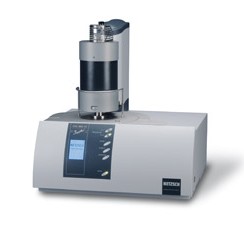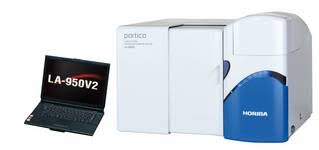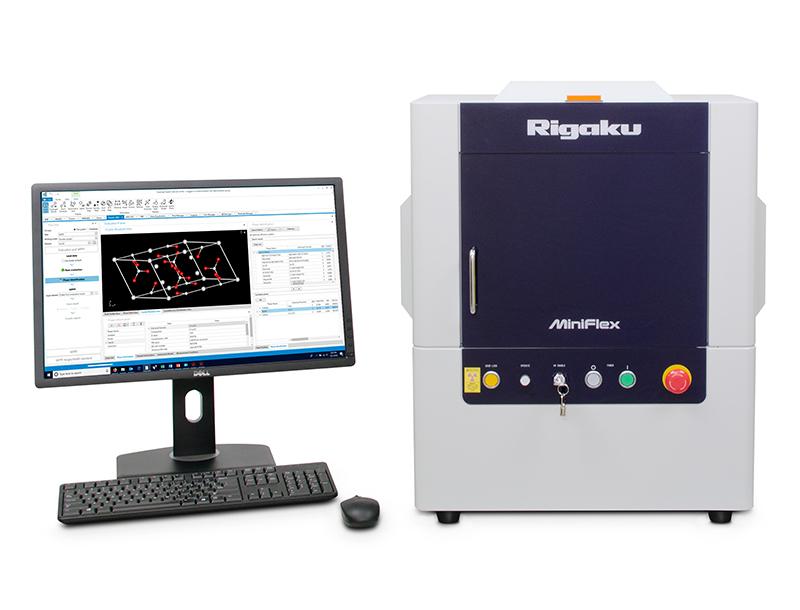Laser Particle Size Analyzer (Horiba Partica LA–950)
Overview
The Partica LA-950 Laser Diffraction Particle Size Distribution Analyzer is a high-end particle sizing instrument. Applications range from studies involving nanoparticles to soils and sediments.
Principle of Operation
The instrument applies the Mie Scattering Theories using a diode laser of 650nm wavelength and a LED of 405nm wavelength for the measurement of particle size distribution of powders, suspensions or emulsions. The existing unit (standard) measures the distribution of particles suspended in a liquid (water, ethanol, and isopropanol), and is capable of performing measurements on dry powders once equipped with a Dry Measurement Unit.
Components
The fully integrated system is composed of a measurement unit incorporating a diode laser, LED light source, photodetector array, side and rear scatter detectors, control section, sample chamber and a sample recirculating system (which incorporates an ultrasonic probe, flow cell and a centrifugal circulation pump that stirs, disperses and pumps). A computer system controls the instrument and displays results in a wide range of formats.
ICP– OES (Thermo Fisher Scientific iCAP 6300) 
Overview
The iCAP 6300 ICP–OES is a simultaneous spectrometer for rapid analysis of trace elements in a solution down to ppb–ppt levels. The apparatus is widely used in analysis of water and dissolved inorganic materials (soil, minerals, metals, glass, waste, etc).
Principle of Operation
The sample is introduced to the Inductively Coupled Plasma – Optical Emission Spectrometer (ICE–OES) through a nebulizer and is then broken into atoms and ions in a plasma torch, created by purging argon in a RF (radio frequency) generator. Once the exited ions combine with electrons in the cooler regions of the torch and return to their low energy state, light with atom–specific wavelength is emitted. The light from different atoms is separated into its component wavelengths using a diffraction grating. The light intensity for each wavelength is measured with a photomultiplier. By comparing with emissions of a blank, the concentration of the analytes are calculated.
Components
The system includes the ICP spectrometer, chillers, autosampler with probe wash station, and PC with iTEVA program for operating the machine.
X–ray Diffractometer (Rigaku MiniFlex 600)
Overview
The Miniflex 600 is a benchtop general purpose X-ray diffractometer that can perform qualitative and quantitative analysis of polycrystalline materials. It is an essential tool in phase identification and quantification and crystal structure characterization for a wide range of applications such as materials, geology, forensic, food, pharmaceutical, and environmental studies.
Principle of Operation
The X–ray is generated in a Cu x–ray tube, filtered by monochromator to increase sensitivity, collimated to concentrate, and is directed towards the sample. The X–ray is diffracted by the atomic layers of the crystal, and the diffraction pattern is used for the analysis based on the Bragg’s diffraction law (nλ=2d sinθ). The 2θ positions of the diffraction peaks provide a unique fingerprint of the phases present and the intensity and spread of the peaks are used to obtain the quantity of each phase based on the Rietveld Quantitative Analysis method.
Components
The system is equipped with a 2.0 kW Cu X–ray tube, NaI scintillation counter detector, graphite monochromator, and an automated 6–position sample changer with sample spinner. Instrument control and data processing are carried out using a PC. Rigaku’s PDXL Comprehensive Analysis Package is used for data reduction, background elimination, search and peak match with ICDD PDF databases, crystallite size determination, % crystallinity determination, and quantitative analysis.
Simultaneous Thermal Analyzer (NETZSCH STA 449 F3 Jupiter) 
Overview
The STA 449 F3 Jupiter is a powerful state–of–the–art thermal analysis tool for simultaneous Thermograivemetry (TG) and Differential Scanning Calorimetery (DSC) analyses on a sample. It measures the mass change and the heat released/ absorbed by the sample material during heating/cooling for such studies as: melting/ crystallization behavior, phase transitions, oxidation/reduction behaviour, decomposition, thermokinetics, glass transition, etc.
Principle of Operation
The STA system is equipped with a microbalance that measure the mass of the sample as it experiences a prescribed heating/cooling regime. The sample temperature is also precisely measured and compared with a reference material. The data are processed to provide two spectrums, presenting the mass change, and the heat flow to (from) the sample.
Components
The STA includes a high temperature graphite furnace, furnace control and power supply, gas control system, vacuum pumps, top–loading microbalance, TG–DSC sample carrier, and refrigerated bath circulator.
Need more info? For more information?
Contact: Raiden Cobas Acosta,
PhD Engineering Technologist, Department of Materials Science & Engineering Faculty of Applied Science & Engineering,
University of Toronto Wallberg Building, 184 College Street, Suite 135 Toronto, Ontario Canada
www.mse@utoronto.ca T: +1 416 978-5003 | F: +1 416 978-4155 E: raiden.acosta@utoronto.ca

